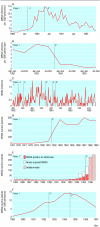Isolation measures in the hospital management of methicillin resistant Staphylococcus aureus (MRSA): systematic review of the literature
- PMID: 15345626
- PMCID: PMC516101
- DOI: 10.1136/bmj.329.7465.533
Isolation measures in the hospital management of methicillin resistant Staphylococcus aureus (MRSA): systematic review of the literature
Abstract
Objective: To evaluate the evidence for the effectiveness of isolation measures in reducing the incidence of methicillin resistant Staphylococcus aureus (MRSA) colonisation and infection in hospital inpatients.
Design: Systematic review of published articles.
Data sources: Medline, Embase, CINAHL, Cochrane Library, System for Information on Grey Literature in Europe (SIGLE), and citation lists (1966-2000).
Review methods: Articles reporting MRSA related outcomes and describing an isolation policy were selected. No quality restrictions were imposed on studies using isolation wards or nurse cohorting. Other studies were included if they were prospective or employed planned comparisons of retrospective data.
Results: 46 studies were accepted; 18 used isolation wards, nine used nurse cohorting, and 19 used other isolation policies. Most were interrupted time series, with few planned formal prospective studies. All but one reported multiple interventions. Consideration of potential confounders, measures to prevent bias, and appropriate statistical analysis were mostly lacking. No conclusions could be drawn in a third of studies. Most others provided evidence consistent with a reduction of MRSA acquisition. Six long interrupted time series provided the strongest evidence. Four of these provided evidence that intensive control measures including patient isolation were effective in controlling MRSA. In two others, isolation wards failed to prevent endemic MRSA.
Conclusion: Major methodological weaknesses and inadequate reporting in published research mean that many plausible alternative explanations for reductions in MRSA acquisition associated with interventions cannot be excluded. No well designed studies exist that allow the role of isolation measures alone to be assessed. None the less, there is evidence that concerted efforts that include isolation can reduce MRSA even in endemic settings. Current isolation measures recommended in national guidelines should continue to be applied until further research establishes otherwise.
Figures

Comment in
-
Preventing the spread of MRSA.BMJ. 2004 Sep 4;329(7465):521. doi: 10.1136/bmj.329.7465.521. BMJ. 2004. PMID: 15345601 Free PMC article. No abstract available.
-
Golden rules.BMJ. 2004 Sep 4;329(7465):538-9. doi: 10.1136/bmj.329.7465.538. BMJ. 2004. PMID: 15345627 Free PMC article. No abstract available.
References
-
- Public Health Laboratory Service. The first year of the Department of Health's mandatory MRSA bacteraemia surveillance scheme in acute NHS trusts in England: April 2001-March 2002. Commun Dis Rep CDR Wkly [serial online] 2002;12: www.hpa.org.uk/cdr/PDFfiles/2002/cdr2502.pdf (accessed 22 Jul 2004).
-
- Hiramatsu K, Hanaki H, Ino T. Methicillin resistant Staphylococcus aureus clinical strain with reduced vancomycin susceptibility. J Antimicrob Chemother 1997;40: 135-6. - PubMed
-
- Turnidge JD, Bell JM Methicillin-resistant Staphylococcus aureus evolution in Australia over 35 years. Microb Drug Resist 2000;6: 223-9. - PubMed
-
- Centers for Disease Control and Prevention. National nosocomial infection surveillance systems report, data summary from January 1992-June 2001, issued August 2001. Am J Infect Control 2002;30: 458-75. - PubMed
-
- Garner JS. Hospital infection control practices advisory commitee. Guideline for isolation precautions in hospitals. Infect Control Hosp Epidemiol 1996;17: 53-80. - PubMed
Publication types
MeSH terms
LinkOut - more resources
Full Text Sources
Medical
